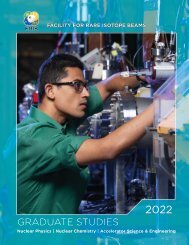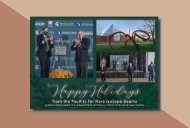2021FRIB/NSCL Graduate Brochure
Create successful ePaper yourself
Turn your PDF publications into a flip-book with our unique Google optimized e-Paper software.
Alex Brown<br />
Professor of Physics<br />
Theoretical Nuclear Physics<br />
BA, Physics,<br />
Ohio State University,<br />
1970<br />
MS, Physics,<br />
SUNY Stony Brook,<br />
1972<br />
PhD, Physics,<br />
SUNY Stony Brook,<br />
1974<br />
Joined <strong>NSCL</strong> in<br />
January 1982<br />
brown@nscl.msu.edu<br />
Selected Publications<br />
Microscopic calculations of nuclear level<br />
densities with the Lanczos method, W.<br />
E. Ormand, and B. A. Brown, Phys. Rev. C<br />
102, 014315 (2020),<br />
New Isospin-Breaking USD Hamiltonians<br />
for the sd-shell, A. Magilligan and B. A.<br />
Brown, Phys. Rev. C 101, 064303 (2020),<br />
Implications of the 36 Ca- 36 S and 38Ca-<br />
38Ar difference in mirror charge radii on<br />
the neutron matter equation of state, B.<br />
A. Brown, et al., Phys. Rev. Research 2,<br />
0223035(R) (2020).<br />
Constraints on Skyrme equations of<br />
state from doubly magic nuclei, ab initio<br />
calculations of low-density neutron<br />
matter, and neutron stars. Y. Tsang, B. A.<br />
Brown, F. J. Fattoyev, W. G. Lynch, and<br />
M. B. Tsang, Phys. Rev. C 100, 062801(R)<br />
(2019).<br />
My research in theoretical nuclear physics is motivated<br />
by broad questions in science: What are the fundamental<br />
particles of matter? What are the fundamental forces and<br />
their symmetries that govern their interactions? How were<br />
the elements formed during the evolution of the Universe?<br />
How do the simplicities observed in many-body systems<br />
emerge from their underlying microscopic properties?<br />
Specific topics of interest include: the structure of light<br />
nuclei and nuclei near the driplines, di-proton decay,<br />
proton and neutron densities, double β decay, isospin<br />
non-conservation, level densities, quantum chaos, nuclear<br />
equations of state for neutron stars, and the rapid-proton<br />
capture process in astrophysics.<br />
The diverse activities within our nuclear theory group,<br />
coupled with the forefront experimental work in nuclear<br />
structure, nuclear reactions and nuclear astrophysics at<br />
<strong>NSCL</strong> provide the perfect environment for the development<br />
of new theoretical ideas. I also have collaborations with<br />
theoretical and experimental groups in many countries<br />
including Germany, France, England, Italy, Norway, Japan,<br />
and South Africa.<br />
I pursue the development of new analytical and<br />
computational tools for the description of nuclear structure,<br />
especially for nuclei far from stability. The basic theoretical<br />
tools include the configuration-interaction and energydensity<br />
functional methods. I work with collaborators to<br />
developed software for desktop computing as well for highperformance<br />
computing.<br />
KEYWORDS<br />
Configuration Interaction Theory | Energy Density<br />
Functional Theory | Applications to Nuclear<br />
Structure and Astrophysics | Applications to<br />
Fundamental Interactions<br />
26






